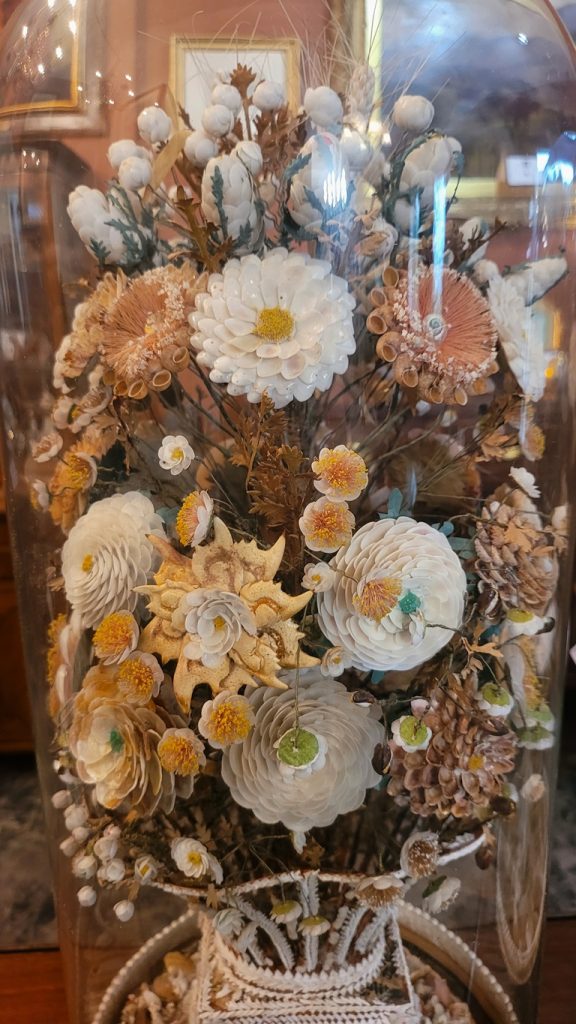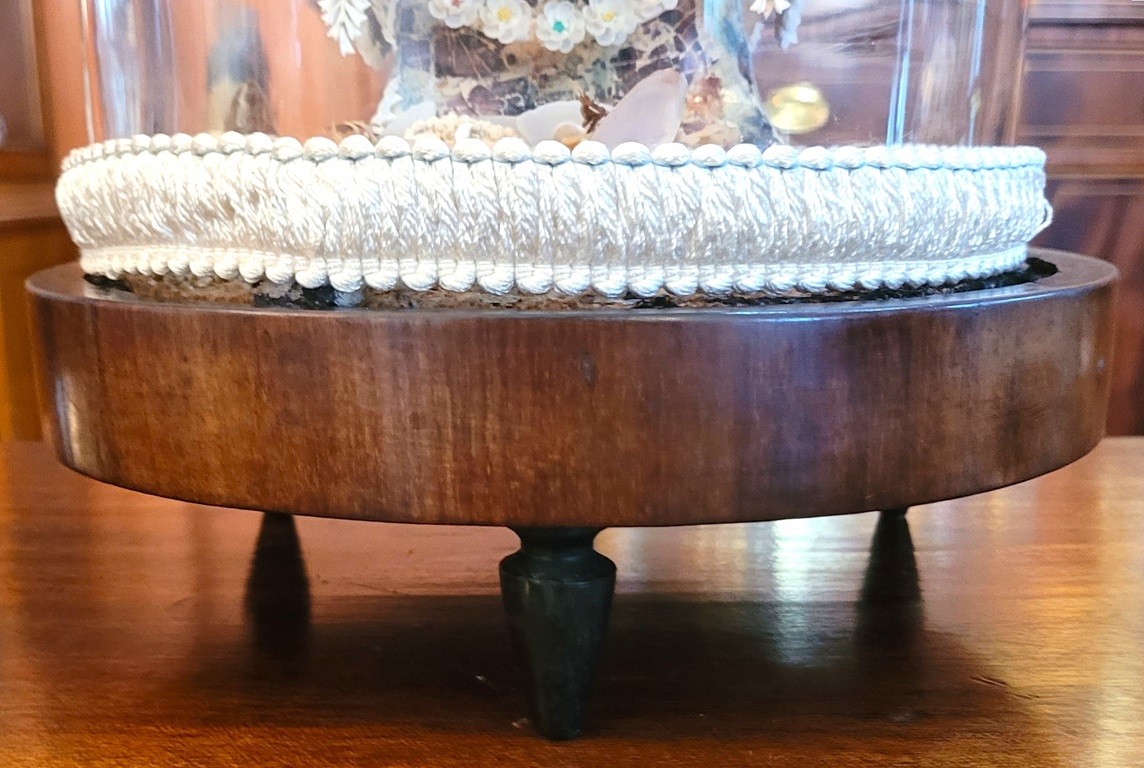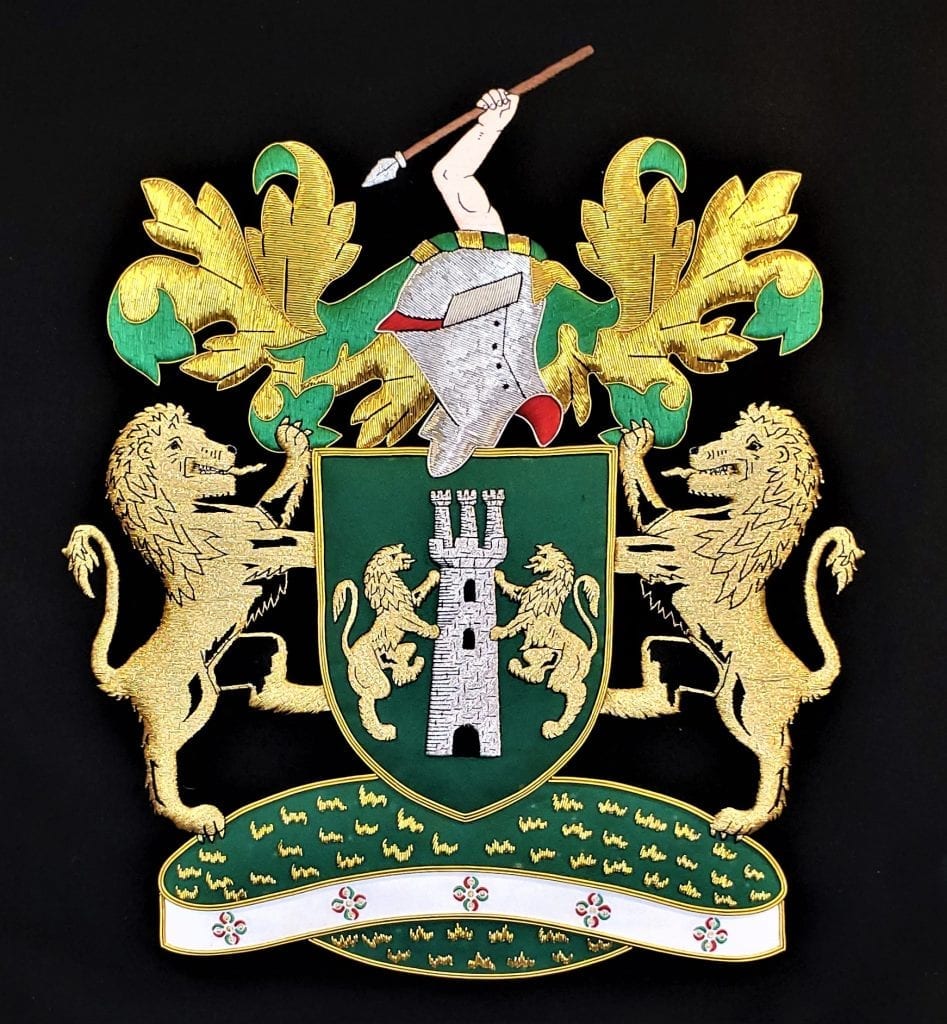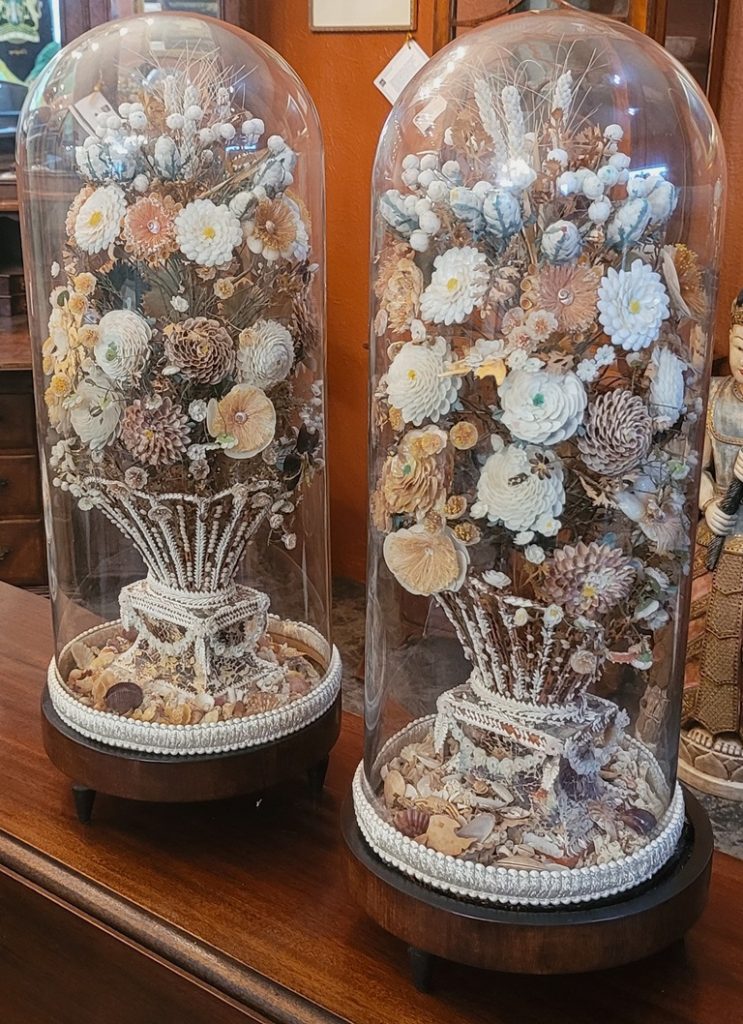Pair of Regency Shell Art Floral Bouquets under Glass Domes – EXCEPTIONAL
PRESENTING A ‘FANTASTICALLY’ RARE, EXCEPTIONAL QUALITY and MUSEUM QUALITY Pair of Regency Shell Art Floral Bouquets under Glass Domes.
Made in England, circa 1820, during the ‘Regency Era’.
These are a MATCHING PAIR of EXTREMELY HIGH QUALITY and EXTREMELY RARE Shell Art Floral Bouquets, under Glass Domes and on mahogany stands.
YOU WILL ONLY FIND A ‘PAIR’ LIKE THIS IN THE VICTORIA & ALBERT MUSEUM IN LONDON, UK!
THESE ARE HIGHLY DESIRABLE AND HUGELY IMPORTANT 19th CENTURY ENGLISH PIECES!
We have only been able to find a pair like this, in the V. & A. in London and a single one at the Brooklyn Museum.
Link: https://www.brooklynmuseum.org/opencollection/objects/87194
Link: http://fineshellart.blogspot.com/2013/08/victorian-ornamental-shellwork.html
The Victoria and Albert Museum (often abbreviated as the V&A), London, is the world’s largest museum of decorative arts and design, housing a permanent collection of over 4.5 million objects. It was founded in 1852 and named after Queen Victoria and Prince Albert. The V&A is located in the Brompton district of the Royal Borough of Kensington and Chelsea, in an area that has become known as “Albertopolis” because of its association with Prince Albert, the Albert Memorial and the major cultural institutions with which he was associated. These include the Natural History Museum, the Science Museum and the Royal Albert Hall. The museum is a non-departmental public body sponsored by the Department for Culture, Media and Sport. Like other national British museums, entrance to the museum has been free since 2001.
The V&A covers 12.5 acres (5.1 ha) and 145 galleries. Its collection spans 5,000 years of art, from ancient times to the present day, from the cultures of Europe, North America, Asia and North Africa. The holdings of ceramics, glass, textiles, costumes, silver, ironwork, jewellery, furniture, medieval objects, sculpture, prints and printmaking, drawings and photographs are among the largest and most comprehensive in the world. The museum owns the world’s largest collection of post-classical sculpture, with the holdings of Italian Renaissance items being the largest outside Italy. The departments of Asia include art from South Asia, China, Japan, Korea and the Islamic world. The East Asian collections are among the best in Europe, with particular strengths in ceramics and metalwork, while the Islamic collection is amongst the largest in the Western world. Overall, it is one of the largest museums in the world.
Since 2001, the museum has embarked on a major £150m renovation programme, which has seen a major overhaul of the departments, including the introduction of newer galleries, gardens, shops and visitor facilities.
New 17th- and 18th-century European galleries were opened on 9 December 2015. These restored the original Aston Webb interiors and host the European collections 1600–1815.
Link: https://en.wikipedia.org/wiki/Victoria_and_Albert_Museum
We have considered, re-considered and debated at length, the age/dating of these pieces, for some time.
Initially, we thought these were Victorian and made circa 1840-60, as Victorians were obsessed with all things involving Nature.
After Darwin’s Publication of the Origin of the Species, Victorians were determined to discover more about Nature and Science.
Exploration and collecting of Natural Things became an obsession.
Besides going outside, Victorians brought nature into their homes. Greenhouses provided flowers and plants year round. Conservatories built in or added to the house brought the room full of greenhouse plants and flowers into the house. Taxidermy was another popular way of bringing nature into the Victorian home.
Exotic Shells from far-flung places were combined to make a STUNNING Floral Display and placed under Glass Domes for protection.
These pieces of ART were truly TREASURED and only the VERY WEALTHIEST AND AFFLUENT OF VICTORIANS could have afforded these!
What a statement of ostentatiousness in your home!
BUT, when we take into account the ‘unmistakably’ British Regency (1795-1837) Style ‘Basket/Plinth/Platform’ complete with Adam’s Style (1780-1820) ‘swags’, we have reached the conclusion and firm opinion, that these pieces of Shell Art were probably made in the Early 19th Century during the ‘Regency Era’, circa 1820.
They are ‘possibly’ Italian (as the one in the Brooklyn Museum), BUT we are of the belief that they are most definitely, British, mainly because of the flower types displayed and the British Regency style Basket, Plinth or Platform.
As British Regency pieces, these are quite possibly the EARLIEST EXAMPLES of this type of art!
Each Display has a mahogany base, with pointed finial tripod feet, which in turn, have a bottom layer of loose shells, sea-life etc. On this sits a Pedestal, made of shell to resemble tortoiseshell. It is in turn surrounded with shell Adams Style swags and shell bordering and molding. On top of the Pedestal sits an Open Basket made again of shell. The Basket is to replicate a basket of flowers. Extending upwards from the basket is the MOST AMAZING Floral Display, ALL again made of shell, to replicate various types of flowers including posies, pansies, marigolds, hydrangeas, roses, buds and sheaf’s of wheat.
SIMPLY STUNNING!
THESE ARE MUSEUM QUALITY PIECES!
Pair of Regency Shell Art Floral Bouquets under Glass Domes
Condition: Considering their age and material of construction this pair are overall in VERY GOOD ORIGINAL CONDITION. One of the glass domes, is a replacement and is ‘slightly’ narrower in diameter, but not noticeable unless both pieces are placed directly beside each other. The silk ribbon border on the base(s) are replacements, but very suitable to the period.
Provenance: From the Private Collection of a High-End Dallas Antique Collector
Dimensions: Each has a Base Diameter of 10.25 inches and each are 25 inches Tall.
SALE PRICE NOW: $30,000 (Pair)











































